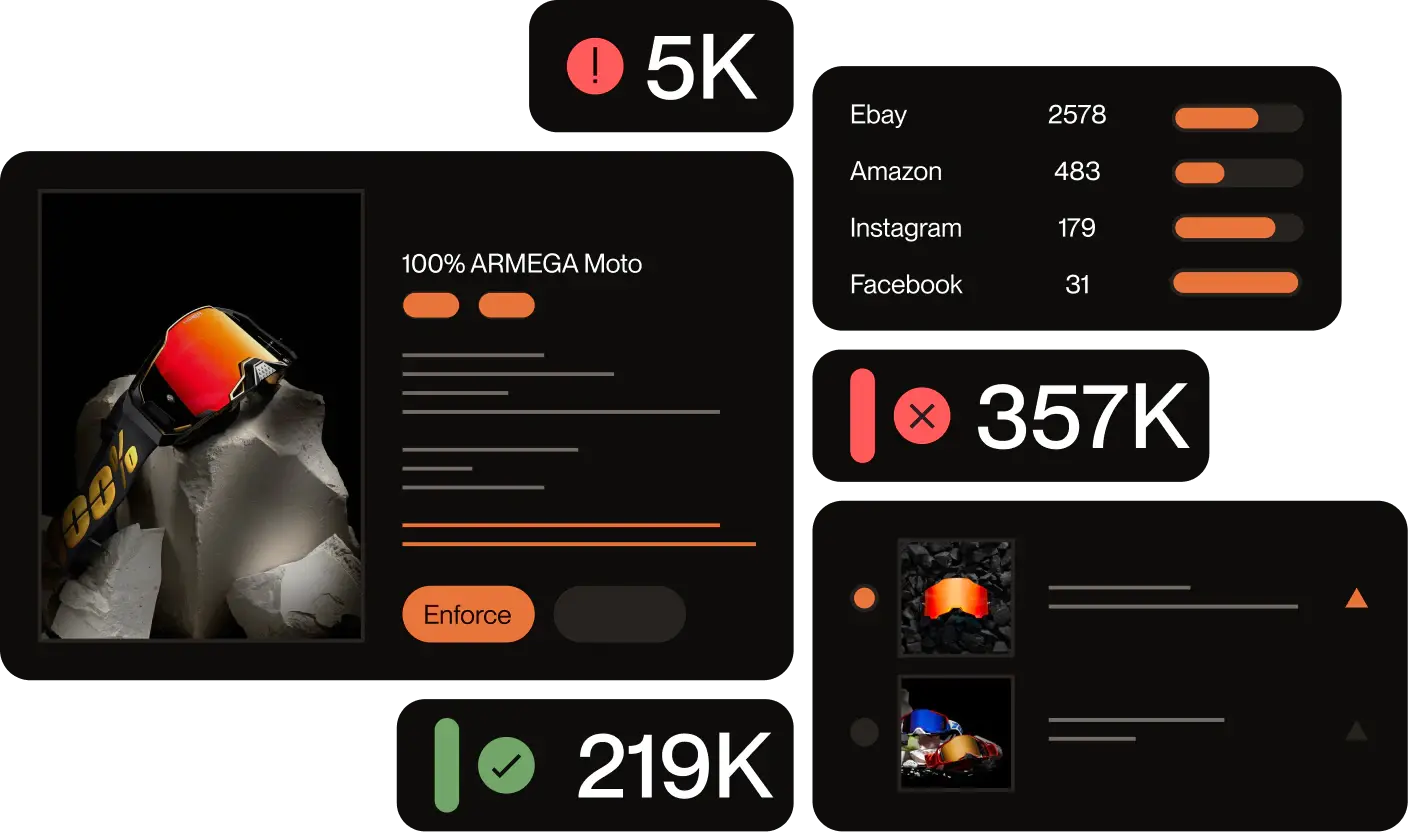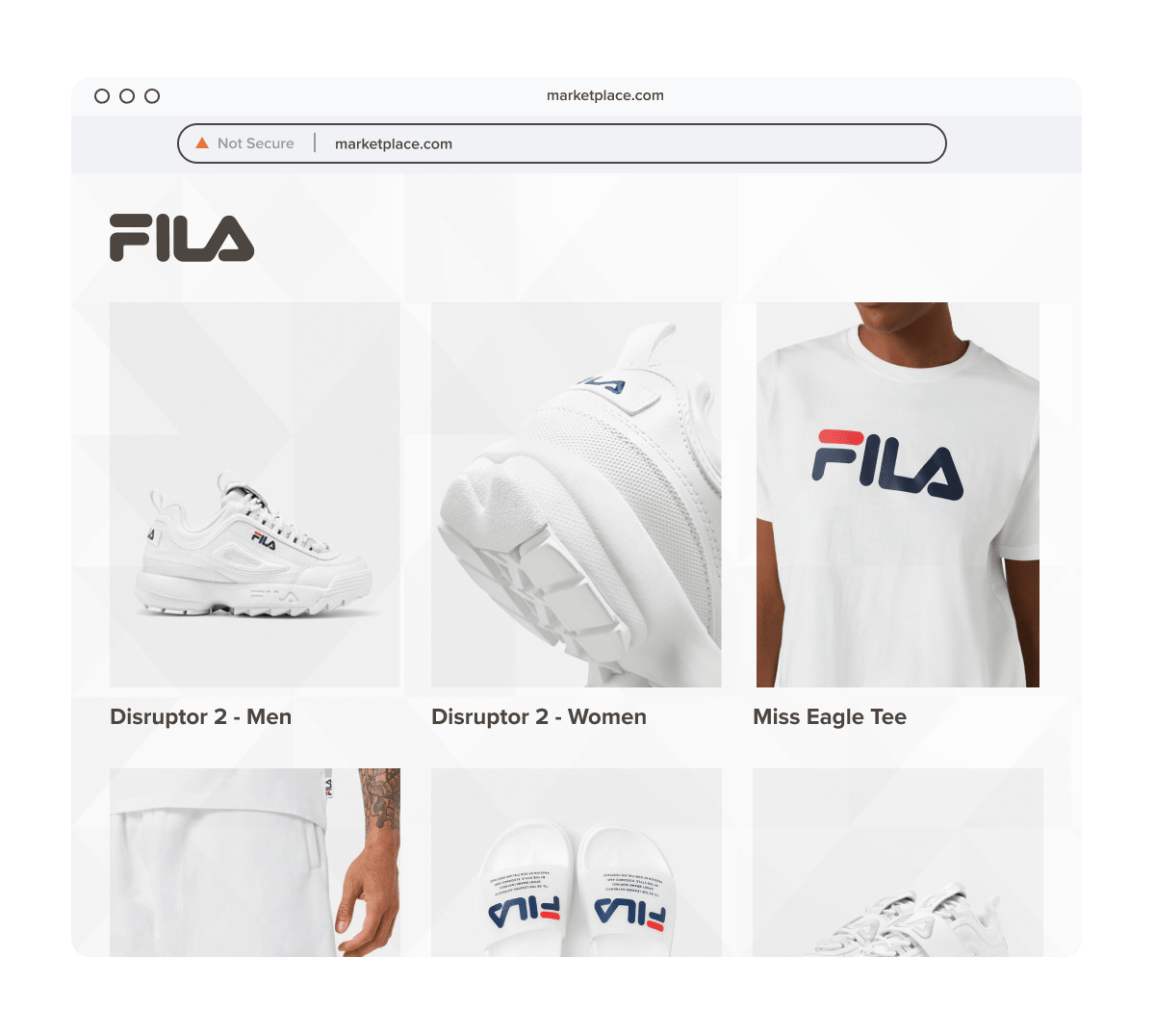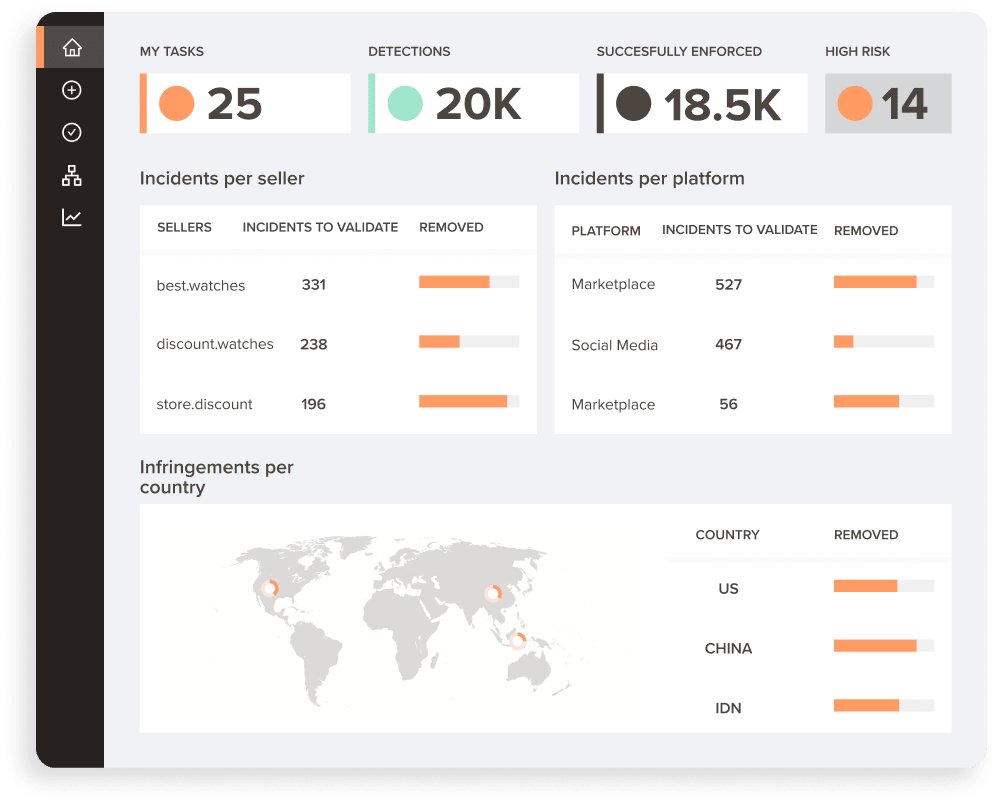Do you want to report a website for copyright infringement and remove it for good?
If you are reading this article, chances are you are already dealing with confused or worse angry customers. Right now, the best thing to do is manage the fallout and put a system in place to prevent cases from re-emerging in the future.
At Red Points, our AI brand protection platform constantly monitors the web to identify and combat all forms of brand abuse. From bad actors misusing your copyrighted images to create counterfeit websites and deceive your customers, to fake ads designed to drive traffic to these fraudulent sites, we’ve seen it all.
In fact, our AI platform has detected 161% increase in fake websites in 2022 and noticed over half obscure their source through proxy servers.
In this article, we’ll share our best practices to report a website for copyright infringement to get it taken down.
How to report a website for copyright infringement
Step-by-step guide to reporting (4 ways)
Drawing from over 10 years of expertise in tackling copyright infringement, we’ve identified several effective strategies for successfully taking down infringing websites.
Today, we’ll walk you through a step-by-step guide to the four main approaches. These include reporting the issue to law enforcement, contacting the hosting provider, submitting a complaint to Google, and creating a DMCA takedown request. Let’s explore each avenue in detail to help you protect your rights effectively.
1. Report infringement to law enforcement
Though copyright infringement is against the law, it’s classified as a civil issue that needs to be solved in court vs. handled by law enforcement. That doesn’t mean, however, that you shouldn’t report the infringement. You can easily report an internet crime to the FBI to officially file the incident.
While they may not be able to do more than record this information, there are cases of fake websites that are violating federal crimes. In this case, the FBI must be notified so they can address the situation. Even if this doesn’t end up being the case, it’s still a good idea to notify them and have an official record of the infringement.
On the FBI’s Internet Crime Complaints website, you’ll find plenty of information to help keep you safe against copyright infringements, as well as a ‘File a Complaint’ button.
Click through and select the same button again at the bottom of the page.
Read the terms for reporting an internet crime, and if you’re happy click “I Accept.”
Complete the 7-step process and fill in the form with as much accuracy and evidence as possible. You can also fill out the form on behalf of someone else but you will still be asked to share your personal information to support the claim.
2. Contact the company that hosts the website
Contact the website host (i.e. WordPress, Bluehost, etc.) of the infringing website to alert them of the incident. You can find the company that hosts the website infringing on your copyright, as well as information on the registrant of the domain, on ICANN.
Web hosts must comply with the DMCA and are held to strict standards in order to stay in operation, so they take infringement seriously. Contacting them right away can speed up the process and save you time, and they may even send a DMCA takedown notice on your behalf.
At the bottom of the ICANN website, select “Dispute Resolution” under the “Help” section in the footer.
Here you can select “Trademark Infringement” or whichever dispute topic is most relevant to your claim.
ICANN recommends speaking with an attorney to resolve any legal disputes regarding your website copyrights. You can see their full policy here.
3. Report infringement to Google
Reporting copyright infringement with Google is essential to ensure the website infringing on your copyrights won’t come up in Google searches. Luckily, this process is fairly simple thanks to the Google copyright infringement form you can access online. The form asks you to choose the scenario you are reporting and leads you through the process so you can easily file your report.
Keep in mind that reporting a copyright infringement to Google doesn’t take down the actual website. This step simply ensures that the website won’t be indexed by Google and won’t come up in search results.
Google’s comprehensive reporting system allows you to report claims across different platforms. Start by choosing the one that is relevant for you.
Continue following the steps, which are simple and easy to follow. If you are asked to submit information and evidence to support your claim, make sure you provide as much detail as possible as this will strengthen your case against the infringement.
4. File a DMCA request against the site
A DMCA request is an official correspondence meant to alert the proper sources of copyright infringement, and can be sent to multiple sources. This can include the domain registrant responsible for the infringement, as well as the web host, search engines, and more. Anywhere the website can be found with your infringing content is a source you can send a DMCA takedown request.
To create a DMCA takedown request,
- Collect evidence of the infringing material online
- Provide evidence of your ownership of the material
- State in the document that you believe the use of the material is unauthorized and this is true under penalty of perjury
- Include your electronic or physical signature
If you’ve never created a DMCA request before, it’s helpful to work with an attorney who can guide you through the process. The Red Points brand protection platform can also file takedown requests on your behalf based on your copyrighted material.
Best practices for gathering proof
You’ll want to be as thorough as possible to build a strong case to get a website taken down. Below are a few things to consider.
- Document website evidence: Gather proof of the infringing website by taking screenshots that include the URL in your browser window and timestamp if possible. You can also document when you noticed the infringement and how many web pages it applies to.
- Gather your ownership evidence: Whoever reviews the report will want to see proof you own the materials in question. Include links to your website to show the original source.
- Gather proof of copyright: Locate your copyright registration certificate. It can also be a good idea to gather some of the materials you used when registering the copyright, like drafts for your designs or documents describing the material.
- Create a comparison: For visual content, it can help to make a side-by-side comparison between your site and the infringing website. You can do this easily by inserting two screenshots in a slide or document editor and taking an overall screenshot of that page.
- Consider a test buy: If the site is selling fake products or not selling anything at all, consider doing a test buy to have evidence of how the site harms customers.
Manual vs. automated approaches
Considering what we just covered, getting a website taken down for copyright infringement takes some work. And if you’re dealing with multiple infringing sites, the hours you spend taking them down can negatively impact other things you can do to grow the business.
If you’re a growing brand, it’s safe to say scammers will try to take advantage of your reputation at some point. We’ve seen a 10% increase in standalone websites with copyright infringements over the last year, which means bad actors aren’t slowing down any time soon.
This is where using a platform like Red Points is helpful. At Red Points’, we offer a robust DMCA takedown service that does 97% of the work when it comes to detecting, reporting, and taking down domains that exploit your brand by infringing on your copyright. This expertise is also coupled with human expertise to ensure the highest level of accuracy.
When you sign up for Red Points, we will monitor the global web for any infringement related to your brand.
Instead of having to issue DMCA takedown notices yourself, our AI brand protection platform will do the work for you on an automated basis. You can pre-define your own rules to take down a website for copyright infringement. See below just how many successfully enforced takedowns one company secured due to our automated software (25,100).
How KEEN dealt with fake sites
American footwear company KEEN has a well-established name in the market that scammers tried to exploit. The company noticed a sudden surge of over 1,400 negative complaints from customers getting scammed on what they thought were Keen’s websites.
It turns out scammers took KEEN’s visuals and content to create fake sites and used Facebook ads to drive traffic. The goal of the scam was simply to steal information. KEEN partnered with Red Points to enforce across a wide range of domains and social media accounts and take back control quickly. Our platform covered 1,000 infringing domains with an enhancement success rate of 93.5%.
Why copyright registration matters when your brand is under attack
Copyright registration forms the basis for your claim when you find a website that infringes on your intellectual property. While copyright registrations are territorial to nations, most countries are part of the Berne Convention and TRIPS Agreement. This means copyrights in one member country are generally accepted in the rest.
Your copyright registration protects your brand’s integrity. It allows you to file DMCA requests and also back up those requests if the receiver declines to follow through. The registration gives you legal standing to go after entities that use your material without authorization.
Also, it is essential before leveraging Red Points solutions to register all of your IP rights. This is what allows our systems to request takedowns on your behalf. We use your unique IPR portfolio to enforce your rights on multiple fronts at once.
Monitoring for new infringements
Our brand protection AI platform continuously monitors the web for unauthorized use of your Intellectual Property. Our main sources of detection include:
- Social media: We monitor and flag ads on social media platforms that could be linked to fake websites.
- Search engines: Our systems crawl major and alternative search engines to uncover infringing websites.
- Domain databases: Fake websites might stay off of search engines to fly under the radar, so our systems also scan domain databases to find URLs that could be spoofing your domain.
Our automated systems use image recognition and computer vision algorithms to discover infringing sites 24/7.
What to do if your takedown request is ignored
If your initial request goes ignored, don’t give up.
- Check that you supplied sufficient evidence of your copyright ownership and the infringing material
- Add evidence if necessary and send another notice referencing the first one
- Include a deadline and a description of your next actions if you don’t hear back again
- Include a cease and desist letter with your attorney’s information
If you still don’t hear back, consider moving it up the ladder to the office that handles intellectual property crime in your region. In the U.S., this is the National Intellectual Property Rights Coordination Center (IPR Center).
In the EU, you can file a report with the European Union Intellectual Property Office (EUIPO). Before you do, be sure to document the investigation you made into the infringing site, including the materials collected and who on your team collected them.
You don’t have to fight counterfeit sites on your own. Enlisting the help of an intellectual property lawyer can make your takedown requests more effective. Besides that, working with a brand protection platform like Red Points allows you to enforce your copyright across a wide area and re-enforce quickly if a request is ignored.
We leverage our partnerships with major platforms to fast-track cases and ensure your brand is respected. We’ve dealt with website owners and hosting platforms who don’t respond to takedown requests right away. Our solutions go beyond initial takedown requests and escalate cases to achieve a 94%.
What’s next
Protecting your brand and intellectual property is no small feat, and it’s understandably frustrating when scammers misuse your hard work to deceive your customers. Worse yet, many customers may not realize—or care—that you don’t control the infringing website.
Fortunately, you have options. You can file a DMCA request with the hosting provider, report the site to Google, or send a takedown request directly to the site owner. Alternatively, you can rely on a comprehensive brand protection solution like Red Points. Our platform not only monitors for infringing websites but also automates their removal, saving you time and effort.
For standalone sites with copyright violations, our systems automatically validate enforcements 74% of the time, leveraging your enforcement history to continuously improve. This combines best-in-class expertise from our team with the industry’s largest AI dataset, giving you unmatched flexibility and precision.
Reach out today for a 15 minute demo with one of our brand protection experts and discover how Red Points can help protect your IP and restore control over your brand.








